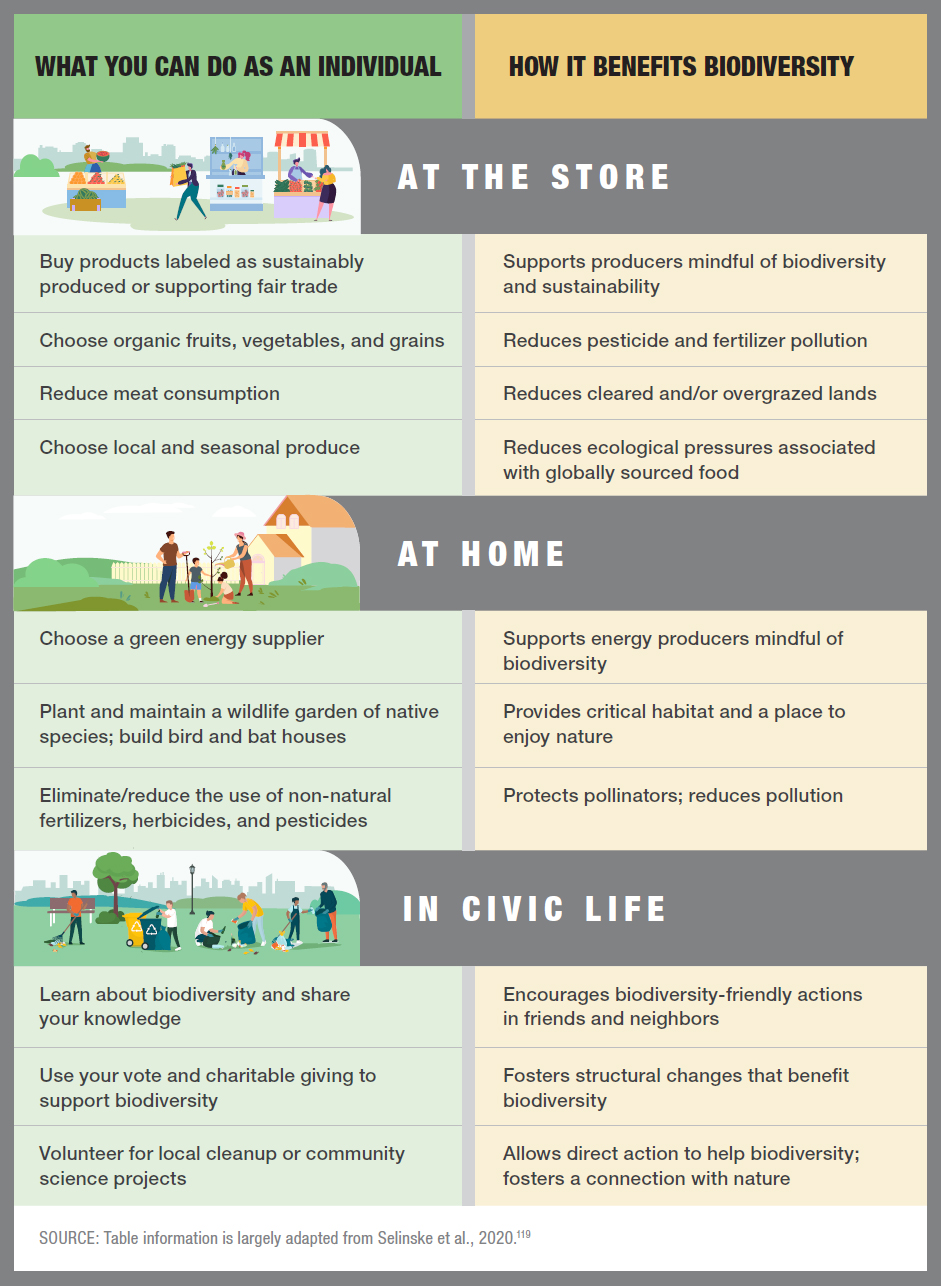 4 WHAT CAN WE DO?
4 WHAT CAN WE DO?
“It’s surely our responsibility to do everything within our power to create a planet that provides a home not just for us, but for all life on Earth.”
—Sir David Attenborough, broadcaster and natural historian
Knowing that maintaining biodiversity is crucial to life on Earth and that it is declining rapidly points to one conclusion: We must work harder to slow and even reverse biodiversity decline or face a future where much of what we value and rely on is lost. Leadership is vital to this effort and world leaders have taken some steps to address this challenge. For example, the Sustainable Development Goals, adopted by the United Nations in 2015, outline objectives for protecting the planet while ending poverty by 2030.71 Separately, a proposed Global Goal for Nature, currently in negotiation, aims to turn our current trajectory around and make humanity nature positive by 2030 and achieve full recovery in biodiversity by 2050.72 These timelines are short and the goals are ambitious because the problem is so urgent, and so important.
However, change is not easy. It takes coordination at local, national, and international levels. It requires working against entrenched practices, such as the clearing of forests for agriculture. The size of the challenge will only grow in the decades ahead. Billions of people still need access to clean water, food, sanitation, and energy, and by 2050, the global population is expected to reach about 10 billion, up from about 6 billion at the century’s start.73 Meeting these demands will only accelerate environmental degradation unless we take action now to change our ways.
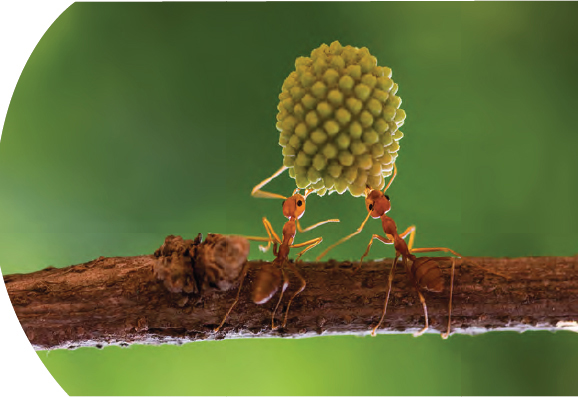
We Can Protect and Restore Biodiversity
Success stories illustrate that conservation efforts can be effective. The recovery of the iconic bald eagle in the United States is one example.74 Decades of habitat destruction, hunting, and exposure to pollutants decimated the population to less than 100 eagles by the 1970s. Like other predators at the top of the food chain, eagles play an important role in ecosystems by culling and controlling populations of rodents and other prey. Today, the bald eagle population is estimated at more than 300,000 thanks to a series of actions that included banning the pesticide DDT, prohibiting the killing of eagles, improving water quality in U.S. lakes and rivers, establishing protected nest areas, and reintroducing eagles in areas where they had been eliminated.

The successful restoration of some fish populations, combined with a greater emphasis on responsible harvest practices and the protection of habitat, has brought not only ecological but also economic benefits. Nearly two decades after fish stocks became so depleted that the fishing technique known as bottom trawling was banned in waters along much of the U.S. West Coast, vast stretches of the Pacific Ocean were reopened to the harvesting of groundfish (such as rockfish). Groundfish populations, having been allowed to rebound, are now considered healthy enough to bring back an entire fishing industry with more sustainable practices. Bottom trawling is allowed again in some areas but restricted in areas deemed essential to fish reproduction and extremely deep waters that contain rare deep-sea corals and sponges.75
Recently, scientists and policy makers have increasingly focused on the protection of marine resources as a way to preserve biodiversity, boost the yields of fisheries, and mitigate climate change.76 This may be particularly efficient if marine protected areas are implemented through a globally coordinated prioritization effort, according to a 2019 study.77 More responsible use of the ocean’s resources could help to reshape the global economy and provide sustainable solutions to meet the food and energy needs of a growing human population.
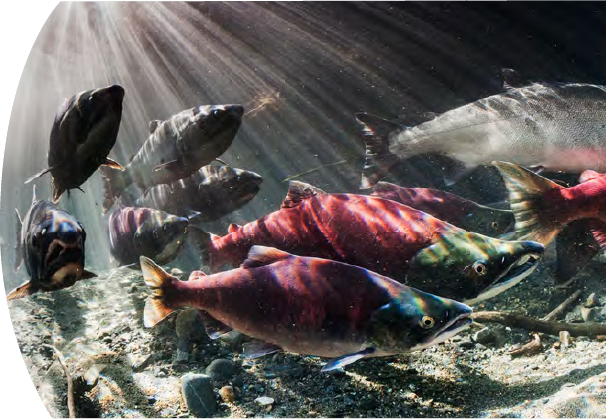
It is even possible to revive entire ecosystems, such as through reforestation. An example of reforestation is the Tijuca forest in Rio de Janeiro, Brazil.78 Cut down to create coffee and sugar plantations in the 1700s, the forest was rebuilt more than 100 years ago to protect Rio’s water supply and is now a celebrated national park that maintains many native plant and animal species, including some that are threatened. More broadly, there are many efforts to replant and reforest, to regain forested ecosystems.

Wildlife rescue, rehabilitation, and “rewilding” can be effective approaches to protecting and restoring biodiversity. Rewilding can involve intentionally reintroducing organisms to an area, or it can mean simply leaving the land alone to let nature take over. The 2,800 square kilometer (just over 1,000 square miles) area surrounding the Chernobyl nuclear plant—the site of one of the world’s worst nuclear disasters—underwent a remarkable transformation in the decades after it was closed to human activity.79 Though it was never intended as a conservation measure, and while many species were adversely affected by radiation from the site, the exclusion of humans from this large area in Northern Ukraine allowed a rebound of once abundant species, including keystone predators such as wolves.
Technology may bring new options for slowing biodiversity loss. For example, in agriculture, scientists are developing technologies for regenerative farming, an approach that seeks to reduce harm to the land and restore and revitalize soil as it is farmed.80 Cities can incorporate technologies and biodiversity-sensitive urban design principles for a more positive relationship with nature.81 And as world leaders work to combat climate change and biodiversity loss, scientists are studying ways to help ecosystems adapt; for example, by examining genes that could give corals greater temperature tolerance to prevent coral bleaching.82 Although we cannot yet rely on biotechnology to bring species back from extinction, technological advances offer useful tools to aid many conservation efforts.

The application of genetics can also play a role in helping to preserve biodiversity. Many of the crops we rely on today are highly vulnerable to pests, disease, and climate change. For example, chocolate’s key ingredient is grown from a single species—the cacao tree—which is threatened by rising temperatures in some of the leading regions producing this important crop, such as Ghana and Ivory Coast.86 By preserving the genetic diversity found in wild relatives of crops, which over time have evolved ways of overcoming environmental challenges, we may be able to hedge against these risks. There are tens of thousands of wild or rarely cultivated species that could provide a richly varied range of nutritious foods, resistance to disease, and tolerance of the changing environment87—if they survive. Fortunately, it is now possible to efficiently sequence and catalog the genetic information for all life on Earth, and the emerging field of conservation genomics is exploring how such data can be used to help threatened species.88 Currently, the focus is largely on vertebrate species.
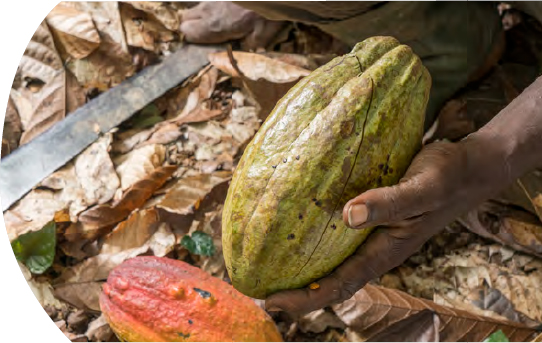
Research in the life sciences and biotechnology is driving an emerging bioeconomy, which features bio-based products such as fabrics made from biosynthetic spider silk.89 Past economic gains from biodiversity, for example, the use of cross-breeding to improve yields in farming, are just the start of what is possible with today’s technological advances; genetic materials fisheries management a treasure trove from which products and ideas might emerge; and their loss could represent missed opportunities.
The Role of Policies and Governance
Well-designed laws and regulations can be effective in bringing about change. The U.S. Endangered Species Act, for example, has helped several hundred species avoid extinction.93 Signed into law in 1973, the Act requires assessments of the impacts on endangered and threatened species of any proposed activities on government and private lands. Other landmark U.S. legislation includes the Clean Air Act in 197094 and the Clean Water Act in 1972,95 both of which delivered dramatic reductions in pollution in U.S. cities and waterways. In the United States and other countries, there are government incentives that target conservation efforts. For example, in Europe, large investments in reforestation for climate change mitigation are under way.
Establishing protected areas is one of the most effective conservation strategies, when they are managed and monitored effectively and are supported by local communities, as well as by civil society more broadly. On land, protected areas include national and state parks and forests, national monuments, and wildlife refuges where human activities such as logging, hunting, fishing, mining, or urban development are prohibited. However, a recent study96 found that even in protected areas, nearly half of the forests are affected by human-caused modifications of their structure, composition, and function. Such modifications reduce many ecosystem benefits and may also precede outright deforestation.

Marine protected areas, where disturbances such as fishing and drilling are prohibited, have repeatedly been shown to improve the diversity and abundance of marine life. Scientists are identifying particularly diverse areas that will guide where marine protected areas are most needed. In addition to protected areas, other effective conservation measures (OECMs) is a newer designation that focuses on retaining biodiversity in ecosystems that are managed or utilized for other activities such as fishing, hunting, low density grazing, or other cultural activities.97 This designation can encompass much larger areas of land and oceans than protected areas and provides opportunities for more equitable practices that support local and Indigenous communities. As of May 2021, at least 16.6% of land and inland water ecosystems globally and 7.7% of coastal waters and oceans are within protected areas and OECMs.98
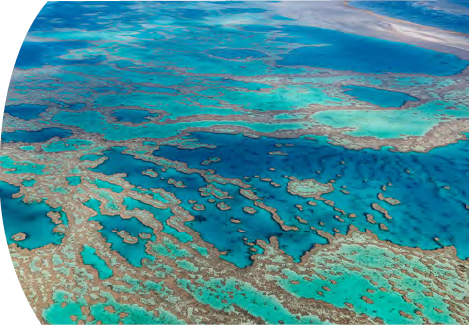
Quarantine regulations and disease-protection practices in trade and travel are also intended to help prevent the catastrophic introduction of invasive species and exposure to disease- causing organisms, respectively. For example, the United States banned the import of salamanders in an effort to keep the chytrid fungus from spreading among native salamander populations.99 Strong restrictions on imports to New Zealand and Australia have been successful in preventing even more non-native species from being introduced there.
Emerging technologies can help to enforce policies and restrictions on entering protected areas or taking prohibited items. In South Africa and Zambia, animal-mounted sensors are being used along with thermal cameras and drones to help park rangers intercept poachers before they can reach protected species.100,101 Several nongovernmental organizations (NGOs) and community-based organizations are involved in managing and enforcing protected areas, especially where laws and regulations are not working well to solve the problem.
Local communities can be highly instrumental in protecting biodiversity. In some cases, the establishment of protected areas has had negative impacts for Indigenous people, such as the Maasai in Tanzania and the Sengwer and Ogiek in Kenya, who have been displaced from their ancestral lands for conservation and ecotourism. However, some nations, such as Australia, Namibia, Canada, and Finland are recognizing the important stewardship role of Indigenous people and have enacted legislation or established programs to protect the rights of Indigenous people to manage their traditional territories and the biodiversity they contain. In fact, Indigenous-managed lands have been found to frequently have higher biodiversity than conventionally protected areas.106 A 2018 report by the National Geographic Society stated that Indigenous people protect 80% of the world’s biodiversity, although their role is not widely recognized.107 Learning from these approaches and embracing Indigenous management of lands can help to bolster conservation in more places.
The Role of International Cooperation
International treaties and agreements provide a means for countries to work together toward common goals. For example, the Montreal Protocol, finalized in 1987, established a plan to phase out the use of chemicals that were depleting Earth’s protective ozone layer.108 At the time, a growing hole in the ozone layer was leading to the bleaching of phytoplankton, the basis of marine food webs, and harming the health of humans and other species by letting in more ultraviolet light from the sun. It was the first treaty to be ratified by all countries in the world, and it has since succeeded in helping the ozone hole to heal.
The Convention on International Trade in Endangered Species of Wild Fauna and Flora (CITES)109 works to ensure that the multibillion-dollar international trade in wild animals and plants—for food, wood, pets, and medicines, among other goods—does not threaten their survival. CITES now includes 182 member countries plus the European Union and strives to provide varying degrees of protection to more than 37,000 species of animals and plants.
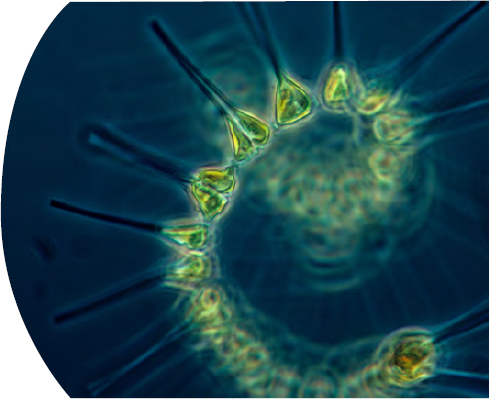
Another international agreement, the Convention on Biological Diversity (CBD),111 was established in 1993 and focuses on the conservation of biological diversity, the sustainable use of the components of biological diversity, and the fair and equitable sharing of the benefits arising out of the use of genetic resources. The 15th major conference of the CBD, held in two parts in 2021 and 2022, will take important steps to set the global intergovernmental policy for biodiversity for the coming decades. The Paris Agreement on climate change,112 adopted by 196 countries in 2015, represents an important step toward protecting biodiversity through actions aimed at avoiding the worst impacts of climate change such as worsening fires, droughts, and extreme weather events. Reversing the climate crisis will require using the tools available now and developing breakthroughs for getting all of our energy from “clean” electricity (produced by renewable sources with steps to minimize the impact on ecosystems), changing how and what we farm, and changing the way we make products such as fertilizers and cement.113

Since 2012, the Intergovernmental Science-Policy Platform on Biodiversity and Ecosystem Services (IPBES) has emerged as a valuable resource for informing and guiding biodiversity conservation and sustainable management efforts worldwide, similar to the role the Intergovernmental Panel on Climate Change (IPCC) has played for advancing knowledge and action on climate change. IPBES and IPCC held their first joint workshop in late 2020 to identify connections and challenges between biodiversity protection and climate change mitigation and adaptation.114

Confronting the Impacts of Our Lifestyle Choices
Perhaps the biggest challenge to slowing biodiversity decline is in changing our present model of interacting with nature and with each other. Vast inequalities between individuals and countries undermine our collective ability to conserve Earth’s resources.115 A person from the richest 1% of the world’s population accounts for 175 times more carbon emissions, on average, than someone from the bottom 10%.116 The drive to meet the insatiable demands of wealthier countries and sectors of society fuels the exploitation of people and natural resources in poorer parts of the world. As a result, the consequences of ecological degradation are often felt most acutely in places where the exploitation is greatest and are largely invisible to those who are the true drivers of that exploitation.
Few people in high-income countries like the United States, Japan, and Western Europe are aware of the impacts their lifestyle choices have in other parts of the world. Beef production, for example, is the leading driver of deforestation in the world’s tropical forests, spurred by the demand in wealthy countries.117 As standards of living improve in rising economies, the demand for beef and other products with a major ecological impact will rise, too.118 Achieving a higher quality of life for billions of people, while addressing climate change and the related decline of biological diversity, requires learning from past mistakes, promoting social justice, and a greater degree of international cooperation than anything we have been able to manage to date. The wealthier nations, which consume most of the world’s resources, have a responsibility to lead the way in addressing ecological harms and the societal inequities associated with them.

The Time to Act Is Now
Halting and reversing the biodiversity crisis and finding approaches to sustainably meet resource demands will require systemic changes to the incentives and costs involved in the ways we build, farm, and live, especially in the wealthier nations of the world.120 The actions of individuals have an important role to play, but the scale of the crisis demands that solutions be driven by large-scale changes in governmental policies and in the economic markets related to them.
Collective actions, taken on the part of nations at all levels of government and in the industrial, agricultural, and transportation sectors will be essential to creating the changes needed to restore Earth’s ecosystems. Nations around the world are paying attention to biodiversity loss and taking steps to address it.* Some of the collective actions that have high potential to address the major drivers of biodiversity loss include:
*In 2021, the United States set a goal of conserving at least 30% of the nation’s lands and oceans by 2030. Globally, the Convention on Biological Diversity (CBD) has developed targets for protected area coverage and accounting of other effective area-based conservation measures.
IN GOVERNMENT
- Respect the rights of Indigenous groups and local communities
- Designate protected areas that are effective and ensure participatory governance and management
- Support restoration and conservation projects
- Participate in international efforts and treaties
- Enact and enforce laws to protect biodiversity
- Ensure that incentives and subsidies align with biodiversity goals
IN FOOD PRODUCTION
- Use farming practices that support biodiversity (e.g., regenerative and agroecological farming)
- Use less water, land, and energy
- Use less fertilizer, pesticides, and antibiotics
- Grow foods that have a low impact on biodiversity
IN INDUSTRY AND BUSINESS
- Commit to supporting biodiversity and communicate that to customers and shareholders121
- Assess the impacts of business processes on biodiversity and work to reduce them
- Reduce the use of water, resources, and energy
- Design products and manufacturing processes to reduce pollution and waste
IN TRANSPORTATION
- Assess the environmental impact of roadways and shipping routes and work to reduce them
- Restore and create plant and animal habitats along roadways
- Monitor and restrict the spread of invasive and exotic species in transporting goods
- Use electric cars, trucks, and trains that are powered by carbon-free energy sources
Biodiversity Is Our Future
The value of biodiversity is incalculable, yet its importance is apparent in every breath we take, every bite of food, every moment spent appreciating the beauty and bounty of the natural world. All life on Earth suffers when biodiversity declines. We can all benefit from restoring a healthy, productive, and diverse home today and for future generations. But time is running out. Each extinction event involves irreversible loss. Pollution and climate change are causing untold changes with impacts that will last for centuries. As our actions throw ecosystems further and further off balance, the risk of their collapse grows higher. There is so much at stake. The choices we make today count. To stem the losses, restore what we can, and reap the benefits of conservation, we must act—and we must act now.


